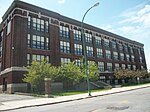Broadway Auditorium

Broadway Auditorium is a former multipurpose arena in Buffalo, New York. It was part of a complex that first opened as Broadway Arsenal in 1858 to accommodate the 65th and 74th Regiments of the New York National Guard. The facility was expanded in 1884 with the addition of a drill hall and administration building to become the Sixty-Fifth Regiment Armory. The armory was decommissioned in 1907, and the City of Buffalo opened the vacant drill hall as Broadway Auditorium in 1913. Broadway Auditorium was home to the Buffalo Majors (AHA), Buffalo Bowmans (IPLL), Canisius Golden Griffins (NCAA) and Buffalo Bisons (NBL). It hosted notable events including the Six Days of Buffalo (1910–1940), NBA Tournament (1911), ABC National Tournament (1914, 1921, 1925 and 1931), NYSPHSAA Basketball Championship (1927), and the World Championship Series (1931–1939). Jimmy Slattery fought at the venue 73 times in his Hall of Fame boxing career, highlighted by his 1930 win over Lou Scozza to become NYSAC Light Heavyweight Champion. After closing in 1940, the building was used as barracks for the 712th Military Police Battalion during World War II. It has served as the Broadway Garage public works storage facility for the City of Buffalo since 1948. The former auditorium is recognized as the world's oldest surviving structure that has hosted professional ice hockey, and has been targeted for historic preservation.
Excerpt from the Wikipedia article Broadway Auditorium (License: CC BY-SA 3.0, Authors, Images).Broadway Auditorium
Nash Street, Buffalo
Geographical coordinates (GPS) Address Nearby Places Show on map
Geographical coordinates (GPS)
| Latitude | Longitude |
|---|---|
| N 42.886833333333 ° | E -78.866083333333 ° |
Address
City of Buffalo Streets Department
Nash Street
14204 Buffalo
New York, United States
Open on Google Maps










